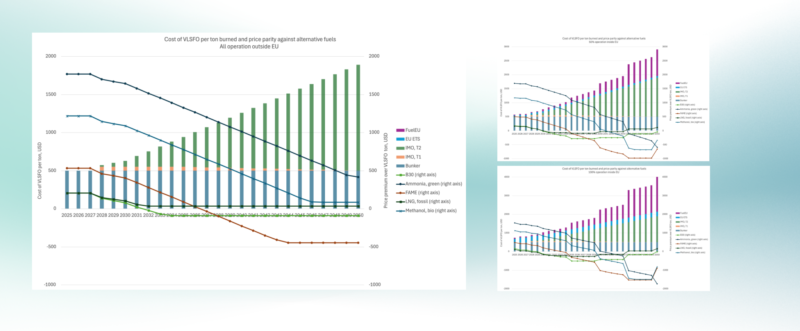May 6, 2025
MEPC 83: Fuel Efficiency at the Heart of Shipping’s Green Transition

After intense negotiations at MEPC 83 meetings, the International Maritime Organisation (IMO) has agreed to a historic Net-Zero Framework, including a Global Fuel Standard that limits the greenhouse gas (GHG) intensity of fuel and a Global Economic Measure based on emissions pricing and trading. Together, these mechanisms aim to curb greenhouse gas (GHG) emissions by at least 70% by 2040 (compared to 2008 levels), with a pathway to net-zero by 2050.
MEPC 82 was about setting the direction. MEPC 83 is about how we get there—with concrete mechanisms that will soon affect bottom lines. While the framework is expected to be ratified in October 2025 for implementation from 2027, the direction is clear: the commercial and regulatory landscape is rapidly shifting towards low-carbon operations. For ship owners and operators, now is the time to take concrete steps to prepare.
What MEPC 83 Means for Your Fleet
As MEPC 83 builds on the IMO’s revised GHG Strategy, the discussions have moved from setting long-term ambitions to defining practical tools for achieving them. The spotlight is on how efficiently ships consume fuel and how well they can monitor and control their emissions over time. This shift puts ship performance and operational efficiency at the heart of compliance. Several MEPC 83 key decisions are:
- Global Fuel Standard (GFS): Ships must progressively reduce their greenhouse gas fuel intensity (GFI) – that is, how much GHG is emitted for each unit of energy used. This is calculated well-to-wake, from 2027 onwards.
- Global Economic Measure (GEM): Vessels exceeding GFI limits will need to purchase remedial units, while efficient ships may earn financial incentives.
- Focus on Well-to-Wake Emissions: Unlike previous approaches that only considered tank-to-wake emissions (those produced during fuel combustion onboard), the new framework also includes the upstream emissions (from fuel production, processing, and transport). They are now formally included in the regulatory calculations, making their reduction more visible in compliance metrics.
- Greater Data Transparency: As GFS and GEM take shape, reliable data on fuel use, emissions, and efficiency will be essential for demonstrating compliance.
These changes make fuel efficiency and data-driven decision-making critical!
The Challenge: Expensive, Less Energy-Dense Fuels
Assuming the framework plays out as intended, it should incentivize the use of zero and near-zero GHG fuels. These bio- and renewable hydrogen-derived fuels are currently scarce and expensive resources, and so the commercial rationale for saving fuel is even clearer.
The green fuel revolution relies on these complementary clean technologies because alternative fuels are less energy-dense (calorific) and more expensive than current oil-based fuels; they offer ship operators less bang for their buck. Essentially, ship operators will need to use more of these more expensive fuels for the same voyage.
To operate with alternative fuels, ship operators will need to:
- Bunker more frequently, incurring extra port costs, and/or
- Increase fuel tank size, reducing cargo space.
Both of these changes are often unavoidable due to the nature of alternative fuels. At the same time, the most effective and broadly beneficial action is to:
- Reduce fuel consumption by investing in technologies that lower the overall fuel demand in the first place.
In fact, improving fuel efficiency is the one action that benefits every ship – regardless of fuel type.
In fact, improving fuel efficiency is the one action that benefits every ship – regardless of fuel type.

Ossi Mettälä, Product Manager, Shipping Solutions, NAPA
Additionally, recent analysis done by Ossi Mettälä, Product Manager at NAPA, shows that “the current remedial unit prices might not be enough to bridge the gap with pricier alternative fuels, potentially delaying price parity significantly, if not indefinitely”. However, regional schemes like FuelEU Maritime and EU ETS could improve this equation.
It remains unclear whether FuelEU Maritime will continue as a fully additional component of the upcoming Global Fuel Standard or be adjusted to align with it once the GFS enters into force. This uncertainty should be kept in mind when assessing potential cost impacts or comparing overlapping regulatory effects.

That being said, the new framework should improve the payback equation for fuel-saving vessel and operational efficiency technologies, such as wind-assisted propulsion systems (WAPS) and voyage optimization software.
From efficiency as a benefit to efficiency as a necessity
Historically, voyage optimization was mostly about finding safe operational conditions. Now, it’s about staying competitive in the near term, as fuel costs rise and efficiency becomes a key differentiator. With fuel scarcity and remedial cost pressures looming, efficiency isn’t just good practice—it’s a regulatory and economic requirement.
- Cut fuel consumption with Voyage Optimization
Fuel is becoming more expensive and less energy-dense. Every drop counts. NAPA Voyage Optimization helps you minimize fuel consumption by selecting the most efficient route for every voyage, considering weather, currents, vessel performance, and arrival windows. Based on joint NAPA-ClassNK research with Marubeni, operators can save up to 7,3% in fuel costs, , helping to lower the amount of penalties under the Global Fuel Standard. - Boost efficiency with wind-assisted propulsion technology
Take your fuel savings further by combining voyage optimization with wind-assisted propulsion systems (e.g., rotor sails, kites, hard or rigid sails, soft sails, suction wings, turbines, and hull forms). NAPA’s solutions seamlessly integrate wind propulsion modeling into routing. A NAPA study with Sumitomo and Norsepower showed that this combination can deliver up to 28% emissions reduction on certain routes. - Monitor GHG intensity and fleet performance in real-time
With the upcoming Global Fuel Standard, operators must monitor their vessels’ GHG fuel intensity closely to avoid penalties and qualify for financial incentives. NAPA Fleet Intelligence provides real-time data on fuel consumption, emissions, and efficiency trends across your fleet. This allows proactive decision-making to keep each vessel within greenhouse gas fuel intensity (GFI) limits and avoid remedial unit costs. - Simulate compliance scenarios before the Global Fuel Standard (GFS) comes into force in 2027
Understanding how your fleet will perform under the new regulations is crucial. NAPA’s tools enable you to simulate future compliance scenarios, showing the impact of different operational strategies, fuel choices, and efficiency technologies. This helps plan cost-effective upgrades and operational changes well before MEPC 83 regulations take effect. - Streamline reporting and data transparency
MEPC 83 requires more detailed and transparent reporting of emissions and energy efficiency. NAPA’s performance monitoring solutions not only support internal optimization but also generate compliant reports for regulatory bodies, making data submission for IMO DCS, CII, and future GFI requirements seamless. - Support just-in-time arrivals with the Blue Visby Solution
Beyond voyage optimization, NAPA is one of the founding members and the leading technology partner of the Blue Visby Solution, a collaborative initiative aimed at reducing emissions by minimizing unnecessary waiting times outside ports. With an innovative contractual framework and state-of-the-art digital technology, the recent series of prototype trials projected fuel and GHG savings of about 29%. All by enabling vessels to reduce their speed and emissions without impacting their commercial performance.
With the cost and availability challenges of alternative fuels and the complexity of emerging economic measures, operational efficiency offers immediate results. By consuming less fuel, shipowners not only cut costs but also lower their GHG intensity, avoid remedial penalties, and position themselves to benefit from future incentives.
Future-proof your fleet with NAPA Fleet Intelligence
From NAPA Voyage Optimization and wind-assisted propulsion integration to real-time performance monitoring and compliance simulation—NAPA gives you the tools to reduce fuel use, cut emissions, and stay ahead of evolving regulations. Get in touch to see how we can help your fleet prepare for the Global Fuel Standard and beyond.
